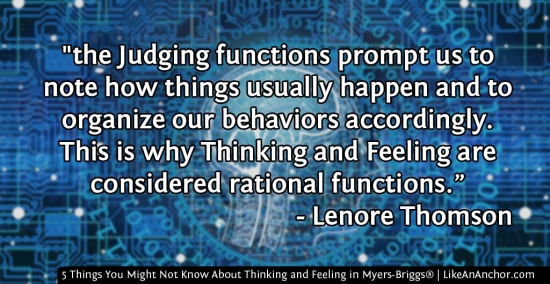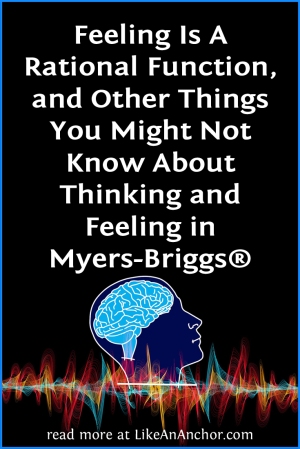In the Myers-Briggs® typology system, a preference for Feeling (F) or Thinking (T) shows up as the third letter in your personality type. But what does it actually mean to use Thinking over Feeling, or vice versa?
You’ve probably heard that Thinking types tend to be more rational and cerebral than Feeling types, who are typically more emotional. There’s a lot more to it than that, though, and the stereotype isn’t entirely accurate. Keep reading to learn 5 things you might not have known about the Thinking and Feeling processes.
They’re Both Judging Functions
Thinking and Feeling are both what we call “Judging” functions. They’re used to describe the psychological process you use most often when making decisions. If you have an F in your four-letter type code, then you use Feeling to make decisions. If you have a T in your type, then you use Thinking.
If you’re a Judging (J) type, then that means you use your judging function to interact with the outer world. A TJ type uses Extroverted Thinking and an FJ type uses Extroverted Feeling as their most comfortable way of making decisions. If you’re a Perceiving (P) type you still have a judging function, but it’s oriented to your inner world. A TP type uses Introverted Thinking and an FP type uses Introverted Feeling.
- To learn more about how functions work check out my post The Simplest Guide To Myers-Briggs® Functions Ever.
Both Thinking Are Feeling Are Rational
One of the biggest surprises when I started diving deeper into research on psychological types is that Feeling and Thinking are both considered rational processes. It’s widely assumed that Thinking is connected with reason and Feeling with emotion, but that’s not quite accurate. In an interview with Richard I. Evans, Psychologist Carl Jung, on whose theories the Myers-Briggs® types are based, said,
“The rational group consists of the two functions, thinking and feeling. The ideal thinking is a rational result. Feeling is also a rational result. They hold rational values. That is differentiated thinking.” (from Jung on Elementary Psychology, p. 140)
In terms more accessible for those not majoring in psychology, Lenore Thomas says that “the Judging functions prompt us to note how things usually happen and to organize our behaviors accordingly.” Thinking and Feeling are both called rational functions because “Rational behavior is always based on predictability — things we know to be true because they happen regularly in the same way” (Personality Types, p.39)

It’s Not About How Much Emotion You Have
Perhaps the most common misconception about these processes is that Feeling means you’re governed by emotion and Thinking means you haven’t got any emotions at all. In fact, whether you use Thinking or Feeling doesn’t determine how much emotion you feel. It just describes the criteria you take into account when making decisions and organizing your behavior, which in turn determines how much you use your emotions in those situations.
Thinking types take into account impersonal rules, laws, and principles. They prefer to use logic when defining terms and problems or ranking their choices. They also tend to look at general trends. To use a pop-culture example, this is how Spock from Star Trek makes decisions. He reasons logically and looks for the “most expedient solution to a problem.”
Feeling types tend to focus more on specific, personal criteria. They prefer to use shared beliefs, values, and moral sensibilities when weighing their options They also identify with others and check-in with their social groups. Dr. McCoy, also from Star Trek, is an example. He’s a scientifically educated and reasonable person, but his decisions are “based on a lifetime of experience with people and cultural assumptions” (Thomas, Personality Types, p.43).
T/F Is Tied To Gender, But Not As Much As You Think
Thinking and Feeling can get confused with traditional gender expectations, with Feeling traits coded feminine and Thinking traits coded masculine. This probably happened because more women than men use Feeling as their decision making function, and more men than women use Thinking. However, the divide isn’t as wide as you might think for how wide-spread the stereotype is.
According to the Center for Applications of Psychological Type, about 57 to 84 percent of women are Feeling types and about 47 to 72 percent of men are Thinking types. It’s hard to get exact numbers on type distribution, but even these broad estimates show that, while the generalization holds true, there are also quite a few Feeling men and Thinking women.

We All Use Thinking And Feeling
Let’s go back to talking about functions for a moment. We all have a Perceiving (Sensing or Intuition) and a Judging (Feeling or Thinking) process that we use most comfortably. But we also have the opposite of those processes in our function stack as well. Sensing types also use Intuition, Intuitive types also use Sensing, Thinking types also use Feeling, and Feeling types also use Thinking.
If you’re a Feeling type, then Thinking is either your tertiary or inferior process. If you’re a Thinking type, then your tertiary or inferior process is Feeling. You won’t use it nearly as comfortably as the one you prefer, but you can access it to a certain extent and work on developing it.
- For an example of how a Thinking type uses Feeling and a Feeling Type uses Thinking, check out my post “Thinking vs Feeling In INxJ Personality Types.”

Want to get copies of the resources mentioned in this post? Click the links below. Please note that these are affiliate links, which means that, at no additional cost to you, I will receive a commission if you follow the link and make a purchase on that website.
- Jung on Elementary Psychology: A Discussion Between C.G. Jung and Richard I. Evans
- Personality Type: An Owner’s Manual, A Practical Guide To Understanding Yourself And Others Through Typeology by Lenore Thomson
Featured image credit: geralt via Pixabay

As an INTJ, I groaned a little at the title haha. 😉😄 I have a hard time understanding when people say “I’m choosing x. It just feels right.” Say what? Did you think this through, earthling? Come on now!
But F is important and it does come into play. I tend to think of psychological experiments that had no heart behind them (like the Stanford prison experiment) or other areas of history where we forgot to see eachother as humans. F’s, we need you.
LikeLiked by 1 person
I wondered if anyone might roll their eyes at the title 😀 Even though I use Feeling I was surprised the first time I saw it described as “rational.” It’s nice to know that our way of rationalizing decisions is needed, though 😉
LikeLiked by 1 person
When people say things like “It just feels right” they are more often talking about Intuition than Feeling in the MBTI sense. The difference between Thinking and Feeling is just that Thinking emphasises truth (decides whether something is true, false, consistent, inconsistent, possible or impossible), whereas Feeling emphasises value (deciding whether something is good, bad, liked, disliked, should or should not happen).
LikeLiked by 3 people